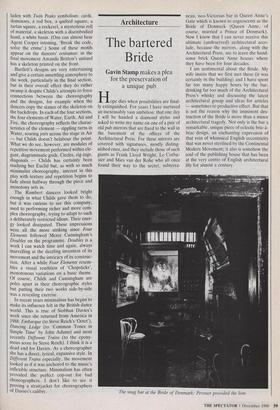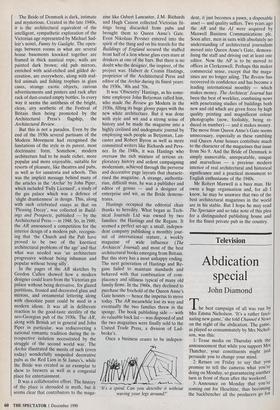Architecture
The bartered Bride
Gavin Stamp makes a plea for the preservation of a unique pub
Hope dies when possibilities are final- ly extinguished. For years I have nurtured an inexcusably vain ambition: that one day I will be handed a diamond stylus and asked to write my name on one of a pair of old pub mirrors that are fixed to the wall in the basement of the offices of the Architectural Press. For these mirrors are covered with signatures, mostly disting- uished ones, and they include those of such giants as Frank Lloyd Wright, Le Corbu- sier and Mies van der Rohe who all once found their way to the secret, subterra-
nean, neo-Victorian bar in Queen Anne's Gate which is known to cognoscenti as the Bride of Denmark (Queen Anne, of course, married a Prince of Denmark). Now I know that I can never receive this ultimate (undeserved) architectural acco- lade, because the mirrors, along with the Architectural Press, are to leave the hand- some brick Queen Anne houses where they have been for four decades.
I am sentimental about the Bride. My wife insists that we first met there (it was certainly in the building) and I have spent far too many happy hours by the bar, drinking far too much of the Architectural Press's whisky and discussing the latest architectural gossip and ideas for articles — sometimes to productive effect. But that is not the reason why the imminent des- truction of the Bride is more than a minor architectural tragedy. Not only is the bar a remarkable, unique piece of eclectic bric-a- brac design, an enchanting expression of that vein of whimsical English eccentricity that was never sterilised by the Continental Modern Movement; it also is somehow the soul of the publishing house that has been at the very centre of English architectural life for almost a century, The snug bar at the Bride of Denmark: Pevsner provided the lion
The Bride of Denmark is dark, intimate and mysterious. Created in the late 1940s, it is the architectural equivalent of the intelligent, sympathetic exploration of the Victorian age represented by Michael Sad- leir's novel, Fanny by Gaslight. The open- ings between rooms in what are several house basements knocked together are framed in thick nautical rope; walls are painted dark brown; old pub mirrors, enriched with acid-etched and gilded de- coration, are everywhere, along with stuf- fed animals and fishing trophies in glass cases, strange exotic objects, curious advertisements and posters and rack after rack of dust-coated empty bottles. In every way it seems the antithesis of the bright, clean, airy aesthetic of the Festival of Britain then being promoted by the Architectural Press's flagship, the Architectural Review.
But this is not a paradox. Even by the end of the 1930s several partisans of the Modern Movement had recognised the limitations of the style in its purest, most doctrinaire form. Somehow, modern architecture had to be made richer, more popular and more enjoyable, suitable for resorts of pleasure, like theatres and pubs, as well as for sanatoria and schools. This was the implicit message behind many of the articles in the 'Archie' by John Piper, which included 'Fully Licensed', a study of the gin palace which was a defence of 'slight drunkenness' in design. This, along with such celebrated essays as that on 'Pleasing Decay', was collected in Build- ings and Prospects, published — by the Architectural Press — in 1948. So, in 1949, the AR announced a competition for the interior design of a modern pub, recognis- ing that 'the Church and the Pub have proved to be two of the knottiest architectural problems of the age' and that what was needed was 'an architecture progressive without being inhuman and popular without being silly'.
In the pages of the AR sketches by Gordon Cullen showed how a modern designer could learn from the Victorian gin palace without being derivative, for glazed partitions, frosted and decorated glass and mirrors, and ornamental lettering along with chocolate paint could be used in a modern idiom. It was all in deliberate reaction to the good-taste sterility of the neo-Georgian pub of the 1930s. The AR, along with British art in general and John Piper in particular, was rediscovering a national romantic tradition during the in- trospective isolation necessitated by the struggle of the second world war. The Archie illustrated the merits of such (even today) wonderfully unspoiled decorative pubs as the Red Lion in St James's, while the Bride was created as an exemplar to show to brewers as well as a congenial place for entertainment.
It was a collaborative effort. The history of the place is shrouded in myth, but it seems clear that contributors to the maga- zine like Osbert Lancaster, J.M. Richards and Hugh Casson collected Victorian fit- tings being discarded from pubs and brought them to Queen Anne's Gate. Even Nikolaus Pevsner entered into the spirit of the thing and on his travels for the Buildings of England secured the stuffed front half of a lion whose glass eyes stare at drinkers at one of the bars. But there is no doubt who the designer, the inspirer, of the project was: Hubert de Cronin Hastings, proprietor of the Architectural Press and editor of the Archie during its finest years: the 1930s, '40s and '50s.
It was 'Obscurity' Hastings, as his some- time employee John Betjeman called him, who made the Review go Modern in the 1930s, filling its huge glossy pages with the new white architecture. But it was done with style and wit and a strong sense of history and he made the magazine into a highly civilised and undogmatic journal by employing such people as Betjeman, Lan- caster and Robert Byron as well as more committed writers like Richards and Pevs- ner. In the 1940s, it was Hastings who oversaw the rich mixture of serious ex- ploratory history and ardent campaigning modernism, achieved through the perverse and decorative page layouts that characte- rised the magazine. A strange, authorita- rian, difficult man, he was a publisher and editor of genius — and a designer of enterprise and wit, as the Bride demons- trates.
Hastings occupied the editorial chair thanks to heredity. What began as Tech- nical Journals Ltd was owned by two families: the Hastings and the Regans. It seemed a perfect set-up: a small, indepen- dent company publishing a monthly jour- nal of international stature, a weekly magazine of wide influence (The Architects' Journal) and most of the best architectural books emerging from Britain. But this story has a most unhappy ending. The next generation of Hastings and Re- gans failed to maintain standards and behaved with that combination of com- placency and silliness typical of many old family firms. In the 1960s, they declined to purchase the freehold of the Queen Anne's Gate houses — hence the impetus to move today. The AR meanwhile lost its way and eventually the two families threw in the sponge. The book publishing side — with its valuable back list — was disposed of and the two magazines were finally sold to the United Trade Press, a division of Lad- broke's.
Once a business ceases to be indepen- 'It's a spiral. Can you describe it without waving your legs around?' dent, it just becomes a pawn, a disposable asset — and quality suffers. Two years ago the AR and the AJ were acquired by Maxwell Business Communications plc. Soon after, men in suits with absolutely no understanding of architectural journalism moved into Queen Anne's Gate, demora- lising the staff and driving out at least one editor. Now the AP is to be moved to offices in Clerkenwell. Perhaps this makes commercial sense, except that the maga- zines are no longer ailing. The Review has recovered its confidence and has become a leading international monthly — which makes money. The Architects' Journal has been the best of weeklies, combining news with penetrating studies of buildings both new and old which are given force by high quality printing and magnificent colour photographs (now, foolishly, being re- duced in number) — and it makes money. The move from Queen Anne's Gate seems unnecessary, especially as these rambling real Queen Anne houses contribute much to the character of the magazines that issue from No 9. And the Bride of Denmark is simply unmovable, unrepeatable, unique and marvellous — a precious modern interior of real architectural and historical significance and a practical monument to English enthusiasms of the 1940s.
Mr Robert Maxwell is a busy man. He owns a huge organisation and, for all I know, he may be unaware that two of the best architectural magazines in the world are in his stable. But I hope he may read The Spectator and so take note of this plea for a distinguished publishing house and for the finest private pub in the country.











































































 Previous page
Previous page